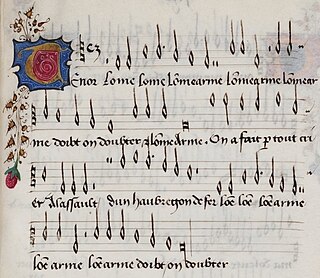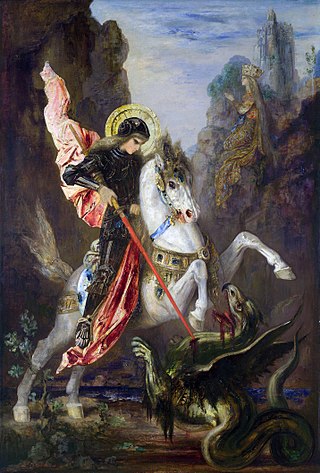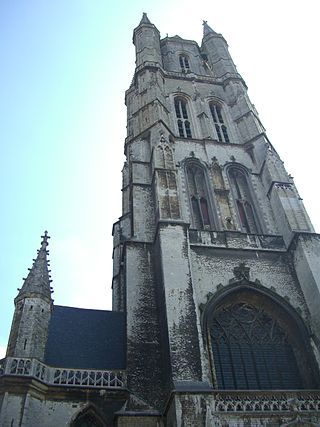
Josquin Lebloitte dit des Prez was a composer of High Renaissance music, who is variously described as French or Franco-Flemish. Considered one of the greatest composers of the Renaissance, he was a central figure of the Franco-Flemish School and had a profound influence on the music of 16th-century Europe. Building on the work of his predecessors Guillaume Du Fay and Johannes Ockeghem, he developed a complex style of expressive—and often imitative—movement between independent voices (polyphony) which informs much of his work. He further emphasized the relationship between text and music, and departed from the early Renaissance tendency towards lengthy melismatic lines on a single syllable, preferring to use shorter, repeated motifs between voices. Josquin was a singer, and his compositions are mainly vocal. They include masses, motets and secular chansons.

The Mass is a form of sacred musical composition that sets the invariable portions of the Christian Eucharistic liturgy, known as the Mass.
A parody mass is a musical setting of the mass, typically from the 16th century, that uses multiple voices of another pre-existing piece of music, such as a fragment of a motet or a secular chanson, as part of its melodic material. It is distinguished from the two other most prominent types of mass composition during the Renaissance, the cantus firmus and the paraphrase mass.

John Taverner was an English composer and organist, regarded as one of the most important English composers of his era. He is best-known for Missa Gloria tibi Trinitas and The Western Wynde Mass, and Missa Corona Spinea is also often viewed as a masterwork.
Antoine Brumel was a French composer. He was one of the first renowned French members of the Franco-Flemish school of the Renaissance, and, after Josquin des Prez, was one of the most influential composers of his generation.
In music, a cantus firmus is a pre-existing melody forming the basis of a polyphonic composition.

Antoine Busnois was a French composer, singer and poet of early Renaissance music. Busnois and colleague Johannes Ockeghem were the leading European composers of the second half the 15th century, and central figures of the early Franco-Flemish School.

Pierre de la Rue was a Franco-Flemish composer and singer of the Renaissance. His name also appears as Piersson or variants of Pierchon and his toponymic, when present, as various forms of de Platea, de Robore, or de Vico. A member of the same generation as Josquin des Prez, and a long associate of the Habsburg-Burgundian musical chapel, he ranks with Agricola, Brumel, Compère, Isaac, Obrecht, and Weerbeke as one of the most famous and influential composers in the Netherlands polyphonic style in the decades around 1500.

"L'homme armé" is a secular song from the Late Middle Ages, of the Burgundian School. According to Allan W. Atlas, "the tune circulated in both the Mixolydian mode and Dorian mode ." It was the most popular tune used for musical settings of the Ordinary of the Mass: over 40 separate compositions entitled Missa L'homme armé survive from the period.
Johannes Martini was a Franco-Flemish composer of the Renaissance.
In Renaissance music, the cyclic mass was a musical setting of the Ordinary of the Roman Catholic Mass, in which each of the movements – Kyrie, Gloria, Credo, Sanctus, and Agnus Dei – shared a common musical theme, commonly a cantus firmus, thus making it a unified whole. The cyclic mass was the first multi-movement form in western music to be subject to a single organizing principle.
SoS cavato is an innovative technique of Renaissance composer Josquin des Prez that was later named by the theorist Zarlino in 1558 in his Le istitutioni harmoniche as soggetto cavato dalle vocali di queste parole, or literally, a subject 'carved out of the vowels from these words.' It is an early example of a musical cryptogram.

The Missa Caput was a musical setting of the Roman Catholic mass, dating from the 1440s, by an anonymous English composer. It circulated widely on the European continent in the mid-15th century and was one of the best-loved musical works of the early Renaissance in Europe, judging by the number of copies that have survived, and the number of imitations it inspired. It was influential both for its use of a tenor cantus firmus which unified all the movements and for being the first extended composition with a freely composed bass line, a feature with extraordinary ramifications in music history. Among the many composers influenced by it are Guillaume Du Fay and Johannes Ockeghem.
The Missa Pange lingua is a musical setting of the Ordinary of the Mass by Franco-Flemish composer Josquin des Prez, probably dating from around 1515, near the end of his life. Most likely his last mass, it is an extended fantasia on the Pange Lingua hymn, and is one of Josquin's most famous mass settings.

The Missa L'homme armé super voces musicales is the first of two settings of the Ordinary of the Mass by Josquin des Prez using the famous L'homme armé tune as their cantus firmus source material. The setting is for four voices. It was the most famous mass Josquin composed, surviving in numerous manuscripts and print editions. The earliest printed collection of music devoted to a single composer, the Misse Josquin published by Ottaviano Petrucci in 1502, begins with this famous work.

The Missa de Beata Virgine is a musical setting of the Ordinary of the Mass, by Renaissance composer Josquin des Prez. Though formerly believed to have been a late composition due to stylistic reasons, evidence from Burchard’s Diary proves that the mass was written sometime before September 23, 1497. It was the most popular of his masses in the 16th century.
The Missa Sine nomine is a setting of the Ordinary of the Mass by Renaissance composer Josquin des Prez. It is a work of his maturity, probably dating from the period after he returned to Condé-sur-l'Escaut in 1504. It is one of Josquin's only masses not to be based on pre-existing material, and like the Missa ad fugam, it is a canonic mass.
Marbrianus de Orto was a Dutch composer of the Renaissance. He was a contemporary, close associate, and possible friend of Josquin des Prez, and was one of the first composers to write a completely canonic setting of the Ordinary of the Mass.

Jheronimus Vinders was a Franco-Flemish composer of the Renaissance, active at Ghent. He was a minor member of the generation after Josquin des Prez, and he also composed a notable lament on the more famous composer's death.
The Missa Gaudeamus is a musical setting of the Ordinary of the Mass by Franco-Flemish composer Josquin des Prez, probably composed in the early or middle 1480s, and published in 1502. It is based on the gregorian introit Gaudeamus Omnes and its setting is for four voices.










